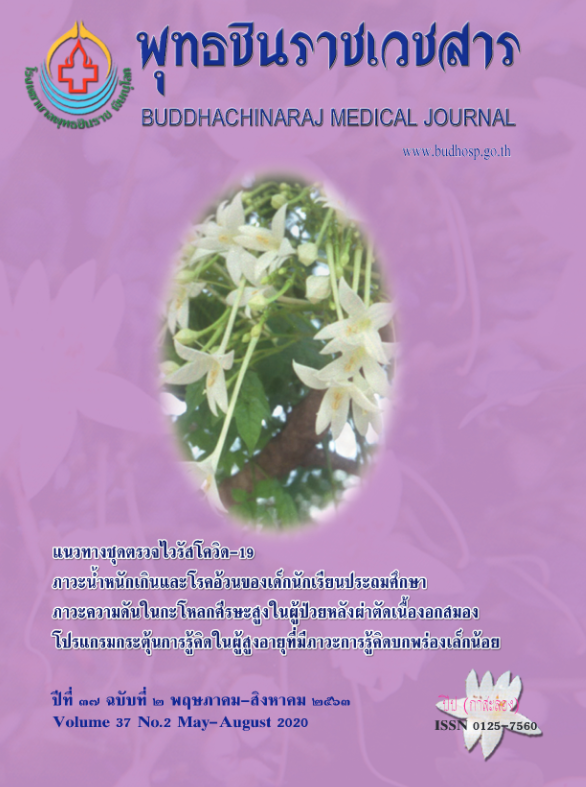สถานการณ์การเข้าถึงยาในบัญชียาหลักแห่งชาติ บัญชียา จ(2) ของผู้ป่วยไทย: การประเมิน จากฐานข้อมูลโรงพยาบาล
สถานการณ์การเข้าถึงยาในบัญชียาหลักแห่งชาติ
คำสำคัญ:
การเข้าถึงยา, บัญชียาหลักแห่งชาติ, บัญชียา จ(2)บทคัดย่อ
การเข้าถึงยาในบัญชียาหลักแห่งชาติที่มีราคาแพงในบัญชียา จ(2) เป็นกุญแจสำคัญที่บ่งบอกความสำเร็จของระบบสาธารณสุข การวิจัยนี้มีวัตถุประสงค์เพื่อวิเคราะห์สถานการณ์การเข้าถึงยาในบัญชียา จ(2) ของบัญชียาหลักแห่งชาติ โดยศึกษาข้อมูลย้อนหลังจากเวชระเบียนผู้ป่วยของโรงพยาบาลพุทธชินราช พิษณุโลกที่ได้รับยาระหว่าง ปีงบประมาณ 2551-2562 นำเสนอการเข้าถึงยา จากผู้ป่วยจาก ICD-10 ในข้อบ่งใช้ที่ได้รับการตรวจวินิจฉัยตามแนวทางกำกับการใช้ยาและได้รับยาบัญชียา จ(2) เป็นค่าร้อยละส่วนผลลัพธ์การรักษาประเมินจากสถานะการจำหน่าย ผู้ป่วย ผลการศึกษาพบว่าจำนวนผู้ป่วยที่เข้าถึงยามาก 5 อันดับแรก คือ ยา bevacizumab 1,474 ราย; peginterferon alfa-2a 1,244 ราย; letrozole 365 ราย; botulinum toxin type A 180 ราย และ docetaxel 165 ราย โดยการเข้าถึงยา เฉลี่ยร้อยละ 22.6 และเข้าถึงได้ทุกสิทธิ์การรักษา สำหรับผลลัพธ์การรักษาที่หายหรืออาการดีขึ้น 5 อันดับแรก คือ ยา erythropoietin alpha และ intravenous immunoglobulin ใน 4 ข้อบ่งใช้ โดยพบอัตรารอด ชีวิตสูงสุดในยา imatinib ในการรักษาโรคมะเร็งเม็ดเลือดขาว (hazard ratio = 0.48, 95%CI 0.32-0.74, p = 0.0002) สรุปได้ว่า ผู้ป่วยสามารถเข้าถึงยาในบัญชียาหลักแห่งชาติที่มีราคาแพงในบัญชียา จ(2) ได้หากเข้าเงื่อนไขการวินิจฉัยโรคและปฏิบัติตาม แนวทางการกำกับการใช้ยา
เอกสารอ้างอิง
2. National Drug List Development Committee. National Drug List 2008. Bangkok: Food and Drug Administration; 2009.
3. National Drug List Development Committee. National Drug List 2013. Bangkok: Food and Drug Administration; 2013.
4. National Drug List Development Committee. National Drug List 2018. Bangkok: Food and Drug Administration; 2018.
5. Cookson R, Hutton J. Regulating the economic evaluation of pharmaceuticals and medical devices: A European perspective.Health Policy 2003;63(2):167-78.
6. Davies L, Coyle D, Drummond M, on the Methodology TEN. Current status of economic appraisal of health technology in the European Community: Report of the network. Soc Sci Med 1994;38(12):1601-7.
7. Drummond M, Jonsson B, Rutten F. The role of economic evaluation in the pricing and reimbursement of medicines. Health Policy 1997;40(3):199-215.
8. Nason E, Husereau D. Round table on real world evidence system readiness-Are we ready to use routinely collected data to improve health system performance. Alberta, Canada: Institute on Health Economics;2014.
9. Turongkaravee S, Tantivaj S, Rattanavipapong W, Kamphang R, Leehawarong P, Teerawattananon Y. Evaluation of high-cost medicine scheme (Category E2) under the 2008 National List of Essential Medicines. Report No.4. Bangkok: Health Intervention and Technology Assessment Program, Ministry of Public Health; 2012.
10. Sruamsiri R, Wagner AK, Ross-Degnan D, Lu CY, Dhippayom T, Ngorsuraches S, et al. Expanding access to high-cost medicines through the E2 access program in Thailand: Effects on utilisation, health outcomes and cost using an interrupted time-series analysis. BMJ Open 2016;6(3):e008671. Available from: https://bmjopen.bmj.com/content/6/3/e008671.share
11. Patikorn C, Taychakhoonavudh S, Thathong T, Anantachoti P. Patient access to anticancer medicines under public health insurance schemes in Thailand: A mixed method study. Thai J Pharm Sci 2019;43(3):168-78.
12. Parkhurst J. The politics of evidence:From evidence-based policy to the good governance of evidence. New York:Routledge; 2017.
13. Asante AD, Zwi AB. Public-private partnerships and global health equity: Prospects and challenges. Indian J Med Ethics 2007;4(4):176-80.
14. Hawkins B, Parkhurst J. The good governance of evidence in health policy. Evid Policy 2016;12(4):575-92.
15. Department for International Development. Increasing access to essential medicines in the developing world: UK Government policy and plans. London: Department for International Development; 2004.
16. Singleton N, Rubin J. What is good governance in the context of drug policy?. Intern J Drug Policy 2014;25(5):935-41.
17. Krattiger AF, Mirza Z, Taubman A, Watal J. Promoting access to medical technologies and innovation: Intersections between public health, intellectual property and trade. Geneva:World Intellectual Property Organization;2013.
18. Kast K, Schoffer O, Link T, Forberger A, Petzold A, Niedostatek A, et al. Trastuzumab and survival of patients with metastatic breast cancer. Arch Gynecol Obstet 2017;296(2):303-12.
19. Bunn PA, Kelly K. New chemotherapeutic agents prolong survival and improve quality of life in non-small cell lung cancer: A review of the literature and future directions. Clin Cancer Res 1998;4(5):1087-100.
20. Denning DW, Ribaud P, Milpied N, Caillot D, Herbrecht R, Thiel E, et al. Efficacy and safety of voriconazole in the treatment of acute invasive aspergillosis. Clin Infect Dis 2002;34(5):563-71.






